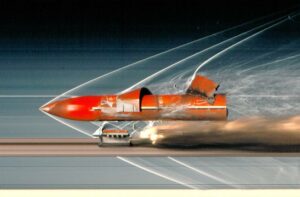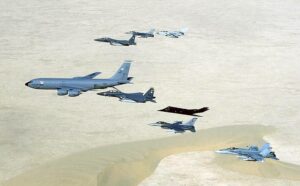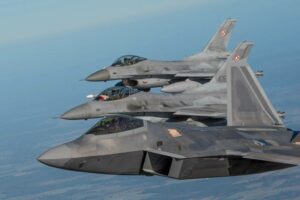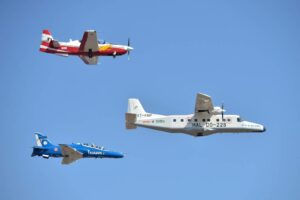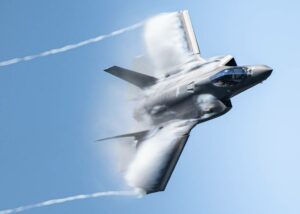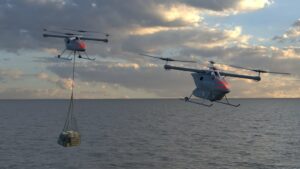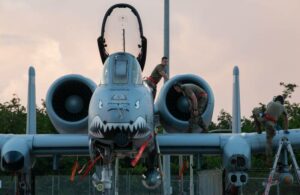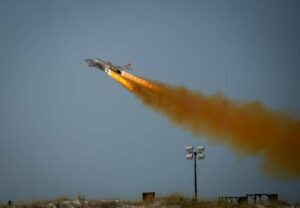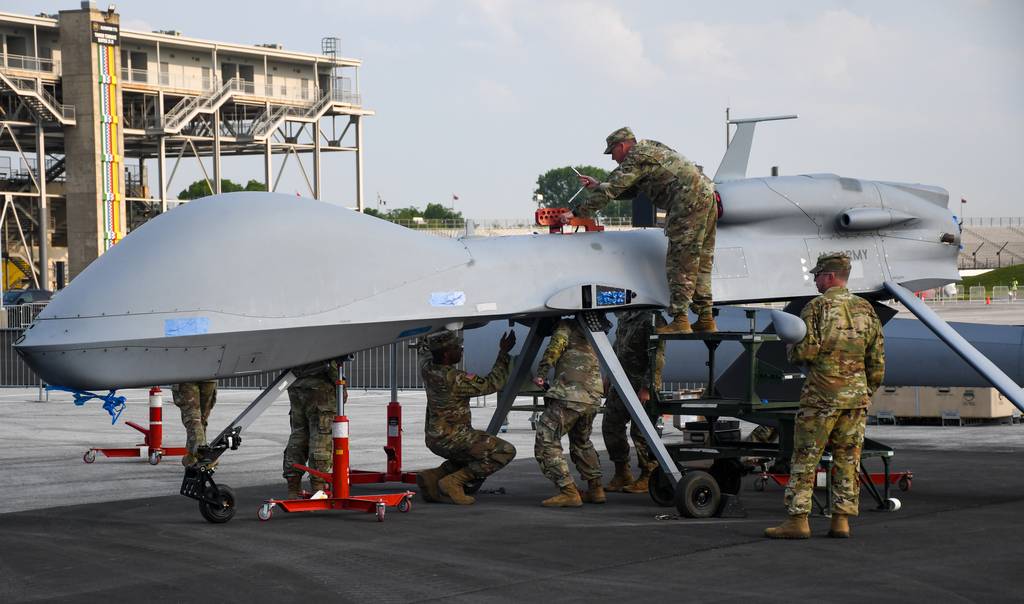
Correction: A previous version of this story misstated the timeline of General Atomics’ testing of the Eagle Eye radar. The correct time frame is available below.
WASHINGTON — A new multidomain surveillance radar from General Atomics Aeronautical Systems, dubbed Eagle Eye, aims to increase the U.S. Army’s ability to track and shoot down even small drones.
Mike Shortsleeve, vice president of Defense Department strategic development at the firm, said in a Monday interview at the Association of the U.S. Army’s conference in Washington that Gray Eagle 25M drones are now in production with Eagle Eye, a synthetic aperture radar.
A fact sheet from General Atomics said Eagle Eye’s synthetic aperture radar can spot targets up to 50 miles away at high resolution, or up to 125 miles when conducting maritime surveillance.
Recent conflicts, such as the Russian invasion of Ukraine and the days-old fighting between Israel and Hamas, show the growing importance of small drones in war, Shortsleeve said. Hamas in part used small, explosive-laden drones to take the Israeli military by surprise, Forbes reported.
The threat from drones is likely to increase, according to Shortsleeve, as technical advancements such as artificial intelligence and machine learning increase their capabilities and as the costs of such systems come down.
That is where General Atomics sees its Eagle Eye-equipped Gray Eagles — working hand-in-hand with other systems that could do the actual shooting down of enemy drones — benefiting the Army, Shortsleeve said.
For example, he added, it would be prohibitively expensive for a Gray Eagle to track and shoot down a small enemy drone with a multimillion-dollar missile. But the Gray Eagle can identify the target, track it and hand that target off to another counter-drone platform that could down an enemy UAV with a less expensive weapon, such as a cannon or directed-energy weapon.
In a May test, he said, the Eagle Eye was able to detect and track a small fixed-wing drone made out of balsa wood — much smaller than forces in the field would likely encounter from an enemy. An earlier test in late 2022 used the radar to shoot down a drone, General Atomics said.
Shortsleeve said Eagle Eye would be able to spot targets in the air, at sea and on the ground.
General Atomics expects to deliver the first tranche of 12 Eagle Eye-equipped Gray Eagle 25Ms to the Army National Guard in the second half of 2026, Shortsleeve said. Another six to 12 will follow for the active duty Army, he said. General Atomics plans to continue producing Gray Eagles with the new radars until the service decides to stop buying them or wants to put a different radar on the new Gray Eagle drones, he added.
The 25M variant of the Gray Eagle also includes open-architecture aircraft and ground systems, a better engine, advanced data links, and improved range, the company said.
General Atomics has been evolving the technology at the core of Eagle Eye for years, but work on the program dramatically accelerated in the last five years, Shortsleeve said.
And loitering munitions of the kind that have gotten considerable use in Ukraine could also be targeted by the Eagle Eye radar, he said.
Some foreign nations have expressed interest in Eagle Eye-equipped drones, Shortsleeve noted, but he declined to identify the countries.
It would be possible to adapt this radar to other platforms beside the Gray Eagle, he said. But in years to come, he added, the Army is only going to need more capabilities to counter small drones in combat.
“The proliferation [of small drones] in combat operations is growing exponentially,” Shortsleeve said. In the future, “it’s going to be undeniable that [unmanned aerial systems] are going to be all over the battlespace, in any large-scale combat operations.”
Stephen Losey is the air warfare reporter for Defense News. He previously covered leadership and personnel issues at Air Force Times, and the Pentagon, special operations and air warfare at Military.com. He has traveled to the Middle East to cover U.S. Air Force operations.
- SEO Powered Content & PR Distribution. Get Amplified Today.
- PlatoData.Network Vertical Generative Ai. Empower Yourself. Access Here.
- PlatoAiStream. Web3 Intelligence. Knowledge Amplified. Access Here.
- PlatoESG. Carbon, CleanTech, Energy, Environment, Solar, Waste Management. Access Here.
- PlatoHealth. Biotech and Clinical Trials Intelligence. Access Here.
- Source: https://www.defensenews.com/air/2023/10/09/general-atomics-new-radar-to-turn-gray-eagles-into-anti-drone-hunters/
- :has
- :is
- :where
- $UP
- 10
- 12
- 125
- 2022
- 2026
- 50
- 70
- a
- ability
- Able
- accelerated
- According
- active
- actual
- adapt
- added
- advanced
- advancements
- aims
- AIR
- Air Force
- aircraft
- All
- also
- an
- and
- Another
- any
- ARE
- Army
- artificial
- artificial intelligence
- Artificial Intelligence and Machine Learning
- AS
- Association
- At
- available
- away
- BE
- been
- below
- benefiting
- Better
- between
- but
- Buying
- by
- CAN
- capabilities
- COM
- combat
- come
- company
- conducting
- Conference
- conflicts
- considerable
- continue
- Core
- correct
- Costs
- could
- Counter
- countries
- cover
- covered
- data
- Defense
- Defense Department
- deliver
- Department
- detect
- Development
- different
- do
- down
- dramatically
- drone
- Drones
- dubbed
- Earlier
- East
- encounter
- Engine
- Even
- evolving
- example
- expects
- expensive
- exponentially
- expressed
- eye
- fact
- field
- fighting
- Firm
- First
- five
- follow
- For
- Forbes
- Force
- Forces
- foreign
- FRAME
- from
- future
- General
- going
- gray
- Ground
- Growing
- Guard
- Half
- hand
- Have
- he
- High
- HTTPS
- identify
- images
- importance
- improved
- in
- includes
- Increase
- Intelligence
- interest
- Interview
- into
- invasion
- Israel
- Israeli
- issues
- IT
- ITS
- jpg
- Kind
- large-scale
- Last
- Late
- Leadership
- learning
- less
- likely
- links
- machine
- machine learning
- made
- Maritime
- May..
- Middle
- Middle East
- Military
- Monday
- more
- much
- National
- Nations
- Need
- New
- news
- noted
- now
- of
- off
- on
- only
- Operations
- or
- Other
- out
- over
- part
- pentagon
- Personnel
- plans
- platform
- Platforms
- plato
- Plato Data Intelligence
- PlatoData
- possible
- president
- previous
- previously
- producing
- Production
- Program
- put
- radar
- range
- Reported
- reporter
- Resolution
- russian
- s
- Said
- SEA
- Second
- sees
- service
- sheet
- Shoot
- shooting
- show
- SIX
- small
- smaller
- special
- Spot
- Stop
- Story
- Strategic
- such
- surprise
- surveillance
- synthetic
- Systems
- Take
- Target
- targeted
- targets
- Technical
- Technology
- test
- Testing
- than
- that
- The
- The Future
- their
- Them
- this
- threat
- time
- timeline
- times
- to
- track
- traveled
- TURN
- u.s.
- U.S. Air Force
- UAV
- Ukraine
- undeniable
- until
- use
- used
- Variant
- version
- vice
- Vice President
- wants
- war
- was
- washington
- when
- will
- with
- wood
- Work
- working
- would
- years
- zephyrnet


